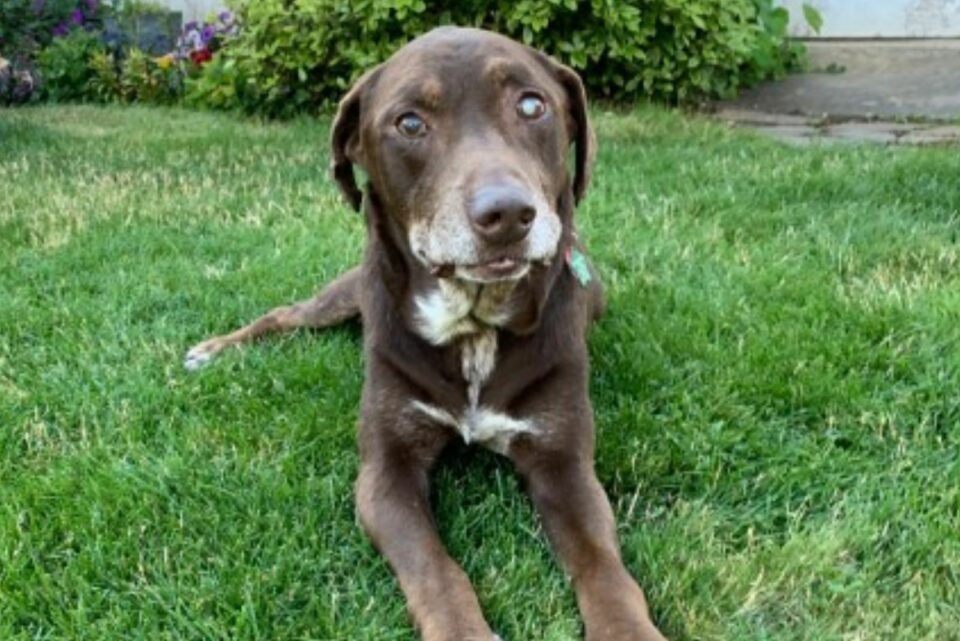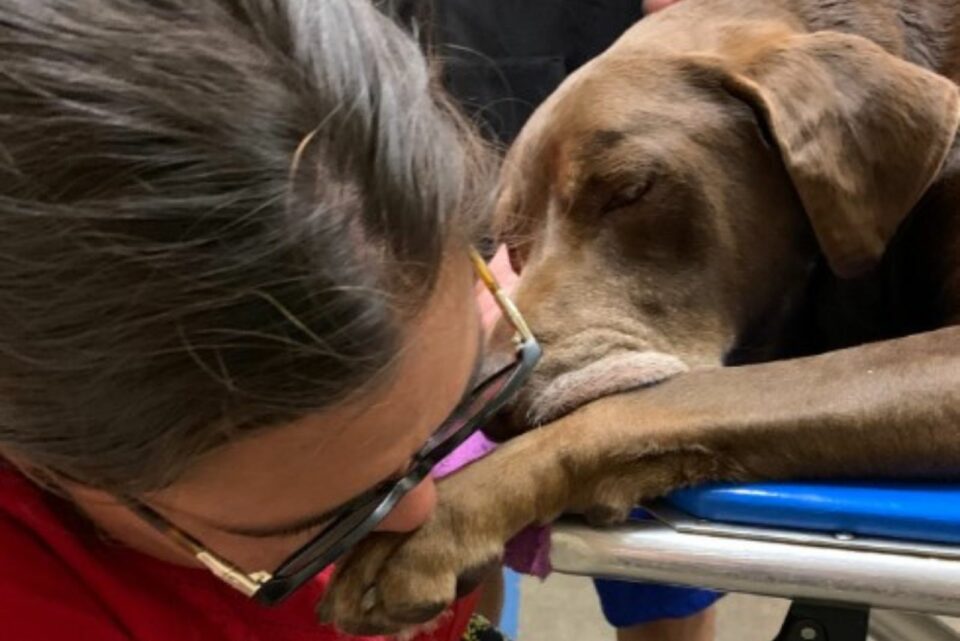Saying goodbye is never easy, especially when you’re saying goodbye to your best friend.
It gets even tougher if that last goodbye means you’ll never get the chance to see that special someone.
Crossing the rainbow bridge is the moment every dog owner dreads.
Frankly, I don’t know what’s scarier: the exact moment of the crossing or the constant fear pecking me in the back of my mind, knowing that moment would come, eventually.
When Kate Schakols, a woman from Texas, brought Rooster home, she was fully aware that their time together was already ticking off.
Rooster was a senior dog, well into his golden years, and a dog with severe health problems.
So, why would a young woman want such an old, sick dog?
To give him the best last days he deserved, that’s why!
It Was The Best Of Times, It Was The Worst Of Times

Old.
Rejected.
Sick.
Hopeless.
Tired of life.
That all was Rooster – a 10- to 12-year-old chocolate Labrador found in Gulf Coast STARS shelter in Brazoria County, Texas.
But, Rooster was also loved, cherished, and rescued, all thanks to Katie Schakols and her family.
“I fell so in love,” Katie told for PEOPLE magazine. “He is just one of the most beautiful dogs I’ve ever seen, inside and out.”
Katie saw past Rooster’s numerous health issues: cataracts that made him go blind in his left eye, worn-out elbow pads, missing teeth from scratching concrete to get food, lumps, bumps, heartworm, etc.

“The bond I had with Rooster was unreal,” adds Katie. “I’d never felt that specific type of connection before, and it was obvious to everyone that he had chosen me to be his person.”
There, an eternal connection was made. Katie and Rooster both knew their time was slipping through the cracks, so they decided to use it the best way they could.
Rooster came into a loving home with Katie, greeted by a younger canine sibling, Bailey. The poor senior pup was showered with love, quite overwhelmed with this feeling he never experienced before.
A pup that used to dig concrete for food and eat dirt and grass was now eating real doggy kibble and stepping on the grass like he was stepping on a soft cloud. Everything around Rooster was sugary-coated. Everything was… nice.

But, good times have to come to an end.
Katie knew Rooster didn’t have much time. Still, the way he left kicked Katie hard in the guts, feeling like someone ripped him apart from her.
On day 28 of Rooster’s sweet new life with Katie, something unexpected happened. You never see it coming, and yet it takes so many dog victims each year.
Bloat, also known as gastric dilatation-volvulus, snuck upon Rooster. His tummy started filling up with air, and it twisted. Rooster was in so much pain.
There was no way to save this brave trooper.
“It was time for us to say goodbye. I know my mom is sad, but I wish she knew these were the best 28 days of my life,” Katie added in the video she posted on her TikTok.
Bloat is treatable in some cases, but still, around 30% of dogs that get it have to be put to sleep forever. Rooster didn’t make it. It was too late for him to have a gastropexy – a survey preventing GDV. |1|
The vet’s hands were tied.

Due to safety measures, Katie couldn’t be there for Rooster’s one last breath. They wheeled him away into a room where he stopped feeling any pain and where he saw the rainbow.
“She whispered in my ear that she’d always love me and is so sorry she couldn’t save me,” says Rooster in the video.
Oh, dear Katie… I hope you know you DID actually save Rooster. Your time together was brief, but you gave him more than he ever experienced in his entire life. You showed him what it’s like to be loved and have a home.
Our time on Earth is so short, and we never know when the end will come. That’s why we have to use the best of it. Let’s do good deeds! Let’s help others in need! Let’s save dogs from shelters and give them the lives they deserve!
Let’s be like Katie. This young woman did not care that Rooster wouldn’t be there for many years to come. She only cared about saving him and showing him life can be beautiful.
The shelters are packed with senior dogs. Rarely does anyone want them. A rescued senior will worship the ground you walk on if you save him. They only need a little loving home and a cozy lap to hide in once bad memories of previous lives kick in.
References:
Jerold S. Bell, DVM. Risk Factors for Canine Bloat. 2003. DOI
If you’ve ever noticed your furry friend’s eyes looking a bit red around the outside, you might be wondering what’s going on. As a seasoned dog enthusiast, you’re no stranger to keeping a close eye on your pet’s health and well-being. Those red rims around your dog’s eyes can be a puzzling sight, prompting you to wonder about the possible reasons behind it.
Your four-legged companion’s eyes are windows to their soul, but they can also reveal subtle hints about their overall health. When those red edges appear, it’s essential to understand the potential causes and how to address them effectively. So, let’s take a closer look at why your dogs’ eyes might be showing this redness and what steps you can take to ensure your furry pal stays happy and healthy.
Understanding Canine Eye Redness
Common Causes of Red Eyes in Dogs
When it comes to your furry friend’s eye redness, there are several common culprits to consider. Allergies, whether from food, plants, or environmental factors, can lead to redness around their eyes. Infections, such as conjunctivitis or even eyelid inflammation, could also be the cause. Additionally, injuries, scratches, or foreign objects in the eye may result in redness.
Recognizing the Signs and Symptoms
To spot if your dog is experiencing eye redness, look out for signs like excessive tearing, squinting, pawing at the eye, or even visible redness or swelling around the eyes. If you notice your dog displaying any of these symptoms, it’s essential to seek veterinary care promptly to address the underlying cause and ensure your pet’s eye health.
Allergies and Environmental Factors
How Allergens Affect Your Dog’s Eyes
Allergies can be a common reason for those red rims around your pup’s eyes. Just like humans, dogs can have allergic reactions to various triggers such as pollen, dust, mold, or certain foods. When your dog comes into contact with these allergens, their immune system may respond by causing inflammation in the eyes, leading to redness. Keep an eye out for any other signs of allergies like itching, skin redness, or sneezing.
Minimizing Exposure to Irritants
To help your furry friend with sensitive eyes, try to reduce their exposure to potential irritants. Regularly clean your home to minimize dust and allergens. Consider using air purifiers to improve air quality. If your dog is prone to allergies, consult with your vet about dietary changes or special hypoallergenic pet products. By taking these steps, you can create a safer and more comfortable environment for your dog, reducing the chances of those red eyes making an appearance.
Infections and Diseases Leading to Red Eyes
Bacterial and Viral Eye Infections
Bacterial and viral eye infections can cause redness around your dog’s eyes. These infections are typically accompanied by symptoms like discharge, squinting, and discomfort. If you notice these signs, it’s crucial to seek veterinary attention promptly. Your vet may prescribe antibiotics or antiviral medications to treat the infection effectively.
Other Health Conditions Affecting the Eyes
In addition to infections, other health conditions can contribute to red eyes in dogs. Issues such as glaucoma, corneal ulcers, or conjunctivitis can lead to redness and discomfort in your pet’s eyes. Regular eye check-ups with your veterinarian can help detect these conditions early, ensuring appropriate treatment and maintenance of your dog’s eye health.
Physical Factors Contributing to Eye Redness
Trauma and Injuries
Injuries to your dog’s eye can lead to redness around the outside. If your dog has been in a scuffle with another animal or hit their eye on something, this could cause irritation and redness. Keep an eye out for any signs of injury or trauma to prevent further complications.
Foreign Objects and Debris
Foreign objects or debris in your dog’s eye can also result in redness. Dust, small particles, or even plant material can get trapped in your dog’s eye, causing irritation and inflammation. Check your dog’s eyes regularly for any foreign objects and seek veterinary help if you notice persistent redness or discomfort.
Diagnostic Approaches for Red Eyes
When to Visit the Vet
If your dog’s eyes have redness around the outside that persists or worsens, it’s essential to schedule a visit to the vet promptly. Red eyes can be a sign of various underlying issues, and early detection is key to providing the necessary treatment and ensuring your dog’s eye health.
What to Expect During the Examination
During the veterinary examination for your dog’s red eyes, the vet will conduct a thorough assessment to determine the cause of the redness. This may involve checking for signs of infections, allergies, injuries, or other eye-related conditions. Be prepared to provide details about your dog’s symptoms and any recent changes in behavior or environment that could be contributing to the issue. The vet may perform tests, such as eye stain tests or cultures, to pinpoint the exact cause of the redness and recommend appropriate treatment options to alleviate your dog’s discomfort.
Treatment Options and Home Care
Medications and Prescriptions
When it comes to treating redness around your dog’s eyes, your veterinarian may prescribe medications depending on the underlying cause. For allergies, antihistamines or corticosteroids can be recommended to reduce inflammation and itching. In cases of infections, antibiotic or antiviral eye drops may be prescribed to clear up the issue. It’s crucial to follow the vet’s instructions carefully to ensure the treatment is effective.
Home Remedies and Preventative Measures
In addition to medications, there are some home care tips and preventive measures you can take to help alleviate redness around your dog’s eyes. Cleaning your dog’s face regularly, especially around the eyes, can help remove any irritants or discharge that may be contributing to the redness. Use a damp cloth or gentle pet wipes to keep the area clean. Avoiding potential allergens like pollen or dust can also help prevent allergic reactions that lead to eye redness. Regular grooming to prevent hair from irritating the eyes and maintaining a healthy diet rich in essential nutrients can support overall eye health and reduce the risk of redness. Remember, if you notice persistent redness or other concerning symptoms, always consult your veterinarian for proper diagnosis and treatment.
Conclusion
So, there you have it – a rundown on why your furry friend might be sporting those red eyes. From allergies to infections and other health issues, it’s crucial to keep an eye on any unusual signs and act fast by seeking advice from your vet. Remember, a little TLC and some professional guidance can go a long way in keeping those puppy peepers bright and healthy. Stay vigilant, stay informed, and most importantly, keep those tail-waggers happy and healthy.
Frequently Asked Questions
What are the common causes of red rims around a dog’s eyes?
The common causes of red rims around a dog’s eyes include allergies, infections, injuries, and underlying health conditions like glaucoma and conjunctivitis.
Why is prompt veterinary care essential for red eyes in dogs?
Prompt veterinary care is crucial for red eyes in dogs to identify the underlying cause early, prevent complications, and start appropriate treatment to alleviate discomfort and prevent worsening of the condition.
How can allergies lead to redness around a dog’s eyes?
Allergies triggered by substances like pollen and dust can lead to eye redness in dogs by causing inflammation and irritation, leading to symptoms like redness, itching, and excessive tearing.
What are the symptoms of bacterial and viral eye infections in dogs?
Symptoms of bacterial and viral eye infections in dogs include discharge, redness, squinting, swelling, and discomfort around the eyes, indicating the need for immediate veterinary attention and treatment.
How can pet owners minimize eye redness due to allergies in dogs?
Pet owners can minimize eye redness in dogs due to allergies by limiting exposure to allergens, maintaining a clean environment, and consulting a vet for dietary modifications or medications to manage allergy symptoms.
What treatment options are available for redness around a dog’s eyes?
Treatment options for redness around a dog’s eyes include medications prescribed by a vet such as antihistamines or antibiotics, along with home care practices like regular eye cleaning and avoiding potential irritants.
Why is regular vet check-up important for a dog with red eyes?
Regular vet check-ups are crucial for a dog with red eyes to monitor their eye health, detect any underlying conditions early, and ensure appropriate treatment to maintain optimal eye health and overall well-being.
[no_toc]

Hey there, I’m Janet Brooks, a dog-loving student from California. I’m all about helping pups in need, especially those without homes. Me and my awesome friends work together to give shelter and love to stray dogs. Oh, and I also write blogs about dogs to share helpful info.